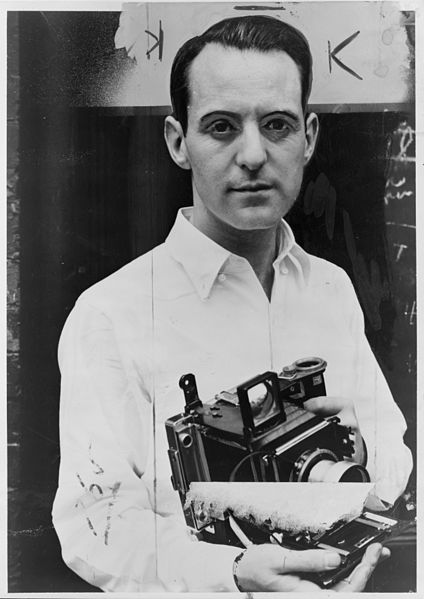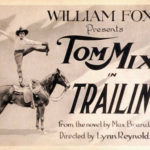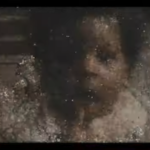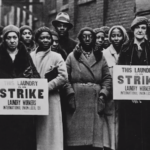“Men and Dust”: Breath That Kills
A Landmark Film in Labor Advocacy and Workplace Safety
n
Miners have been dying from varieties of pneumoconiosis since they have been shuttled via mine elevators to toil in shafts thick with dust that, once it sufficiently scars the lungs, suffocates its victim, but slowly.
In the 1930s, illness rates among miners were so severe that in 1940 the United States Secretary of Labor, Frances Perkins, convened a Tri-State Silicosis Conference in Joplin, Missouri. There, government, labor, and industry leaders from the “Tri-State” region — Oklahoma, Missouri, and Kansas — received a national report that Perkins had commissioned.
When union, labor, and government conferees were done with pitching their interests, claims, and denials, they viewed a short film informed by the report. Titled Men and Dust, it was one of only two films made by the Great Depression-era photographer Sheldon Dick. In 16 minutes, he lamented the silicosis health nightmare.
Last month (December 2013), the U.S. Librarian of Congress recognized the socially and emotionally charged and stylistically innovative film as so significant a contribution to American moving-image art that it merited a place on the U.S. National Film Registry. The Library guarantees that films added to its listing will be preserved in perpetuity, and in the case of Men and Dust presumably that will mean preservation of a copy held at the United States National Archive film collection in College Park, Maryland, just outside Washington DC. (See this earlier MIAN article.)
To understand what made the film so timely and powerful — despite some stylistic excesses that were both ahead of their time, then, and dated, soon after — consider the crisis that prompted organizers to mount the conference, and that motivated Dick to make his film.
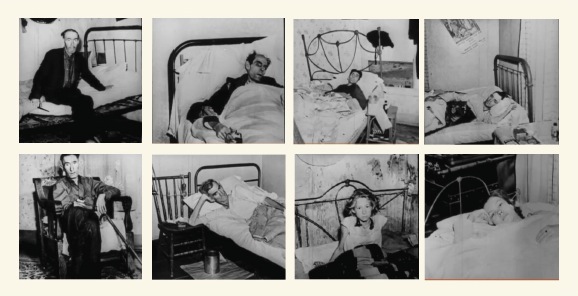
Some of the dying victims of silicosis depicted in “Men and Dust.”
(Click on image to call up video of the 16-minute film.)
n
In the decades before and after the Great Depression, silicosis and similar diseases, all results of prolonged breathing of dust, became more and more pressing an issue of workplace safety.
Silicosis was the concern in the Tri-State area because mining of lead and zinc was a key industry there, and it requires blasting and digging into quartz, the source of silica. Silica breaks down into small particles of crystalline silica, a compound that as dust is akin to a suspension of tiny glass shards. Breathing it draws it as far as the deep recesses of the lungs, where it causes infection and scarring on route to impeding breathing.
Not just mining but many industrial activities produce it in particles a hundredth the size of grains of sand: cutting, sawing, drilling, and crushing of concrete, bricks, rocks, and stone products used in construction. Glass manufacturing and sand blasting generate it, too, as do the operations of foundries, smelters, shipyards, and oilfields. In the mining of quartz and granite, blasting and digging generate it and disperse it as a lingering dust in mine air. Breathing it commonly causes silicosis within a few months to several years.
Coal miners face an analogous danger: coal produces not silica, but coal dust: anthracite. It can cause coalminer’s pneumoconiosis, which is also called black lung, miner’s lung, or anthracosis. In cases of that condition, and of the similar asbestosis, intervals between diagnosis, disability, and death may be months or years.
Between the world wars, public awareness grew of how many men were presenting at medical facilities racked with dust-caused coughs and breathlessness. In mining states like those of the Tri-State region, elected officials and medical workers also had to contend with a rising incidence of silicocis and related diseases among miners’ wives and children. Those patients had merely breathed the silica dust that lifted from the huge piles of mined rock, called tailing piles, that were a key feature of every mining town.

Scenes from “Men and Dust.” The narrator announces the first of these scenes: “He’s quit the mines, forever. He will be dead when the sap flows; he will be dead, in the spring” and says of the third: “You don’t have to be underground to be engulfed in dust.”
n
In their Deadly Dust: Silicosis And The Ongoing Struggle To Protect Worker’s Health (2009, 2nd ed.), David Rosner and Gerald Markowitz write that in the 1930s, silicosis was “a condition that dominated public health, medical, labor, and popular discourse on disease.” The incidence became so pronounced that it galvanized government officials, mining employers, and union leaders.
Addressing the 1940 Tri-State Silicosis Conference, Secretary of Labor Perkins sounded that urgency, but diplomatically: “The owners and operators of these properties have a great moral responsibility, and many of them have acknowledged it,” she said. Those of the Tri-States had demonstrated that by agreeing that their mines could serve as a “laboratory” that could help “to find a way to prevent not only this but similar situations everywhere.”
Industry representatives did not admit to any fault, nor responsibility. An official of the Tri-State Zinc and Lead Ore Producers Association assured the gathering that “insofar as local living conditions are concerned, we are dealing with a social, not an industrial problem, one which is nationwide and worldwide, and exists in many places in this country far more seriously than here. […] With but few exceptions the small minority of employees who have silicosis have it in a mild form.” In fact, he testified that any incidence “cannot be fairly construed either as a direct source of disability or as materially lowering resistance to tuberculosis” which occurred with silicosis and other forms of pneumoconiosis (from Greek pneumon, lung, and konis, dust).
Emboldened, he contradicted even-then accepted epidemiology; he preferred to obfuscate: “As you well know, except in its most extreme form simple silicosis is not a source of disability. It is only when associated with an infection of tuberculosis that it is classifiable as a source of concern.”
In any case, he claimed, most remaining cases in the region were legacies of a time before the industry acted with all its characteristic sense of responsibility: “Even though the industry has made all these efforts…to alleviate the hazard, there is naturally, where such a length of time is involved in obtaining a disease, a residue in the community which we believe is not being created today.”
Not that union leaders had been forthright, either. They had long underreported the incidence of silicosis in order to keep company profits high, strengthening their calls or higher wages for miners. Secretary Perkins seemed to allude to that as she called on the unions, and the miners themselves, to cooperate in continuing investigation of the scourge: “The people who work in those mines and those who represent the organized labor of the community generally, who take upon themselves the duty of speaking up for those who work in the mines, also have a moral responsibility to cooperate with every technical and economic effort to relieve the situation and to find the means of preventing silicosis and tuberculosis.”
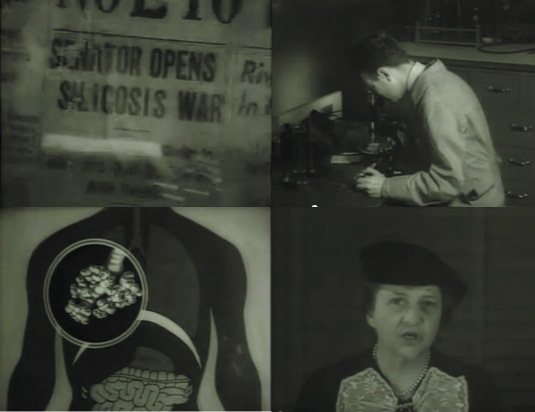
“Stop Silicosis,” 1938, a Department of Labor health-safety film made while Frances Perkins headed the department. Source: Mine Safety and Health Administration, public domain. (Click on image to view the film.)
n
She would surely have known the history of unionists’ and owners’ antagonisms. The bosses of American mining had built their massive wealth on the labor of men and boys treated as disposable beasts of burden.
The authors of Historic Joplin, an online history of the town where the 1940 gathering was held, record that as early as 1914, a U.S. Public Health Service doctor and an engineer from the Bureau of Mines spent a month in and around Joplin investigating pulmonary illnesses among lead and zinc miners. They inspected mines, mining practices, and whatever else seemed germane. At that point, whatever was killing miners at a young age was called “miner’s consumption.” And it was killing them in droves: 14 percent of all deaths in the region were due to it. To that tally could be added the many stricken miners who had moved elsewhere to die. Even by forthcoming mine operators’ counts, fully one in two miners suffered from lung problems. Historic Joplin reports: “One operator offered the frightful story that over a four year period he had employed 750 men in the mine. Of that number, only 50 remained alive and of the 700 who had perished, only a dozen had died from something other than a pulmonary disease.”

Thomas A. Edison, Inc. made “The Temple of Moloch” in 1914 as one its annual holiday-season films. It worked on this one with the National Association for the Study and Prevention of Tuberculosis. Silicosis and other forms of pneumoconiosis were at the time grouped with TB, although they were not contagious.
(To view the film, click on any of the images.)
n
With that level of mortality, and with the range of informants the visiting investigators interviewed – miners, mine managers, mine owners, and plenty of widows – every family in the county was certainly aware of the seeming plague in their midst.
Even the one seemingly significant safety advance between the 1914 and 1940 studies was at best inadequate. In the Tri-State region as elsewhere, mine operators had instituted “wet drilling” in which pumped-in water suppresses dust. But as Historic Joplin notes, water was in reality introduced to soften rock for drilling, while “dust came from many sources, drilling, blasting, popping boulders, and even a process of clearing drill hose by blowing out dust with powerful blasts of air. Nor did the dust immediately settle once disturbed, but had a tendency to fill every part of the mine and simply remain suspended in the air for a considerable amount of time.”
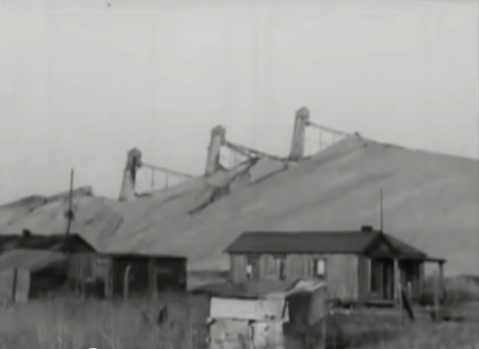
“Men and Dust” — the towns sat in the shadows of the tailing piles.
Dust also rose from tailings — huge piles of mined rock at the mine’s surface — with ambient air currents, let alone strong wind. Nearby, towns’ children played, and all the townspeople breathed.
Men and Dust was Sheldon Dick’s response to this troubling industry history. Its mood is an odd mixture of protestation, lament, and elegy. Not only subject but also narration and a prominent, overwrought musical accompaniment are deployed to intensify the somber yet heroic mood. The novelist and film composer Paul Bowles, at least, thought the soundtrack effective in its use of both music and ambient sounds: talking, singing, and other everyday activities.
It was one of only two films Dick made. Its producer was his wife, Lee Dick, who had made School: A Film about Progressive Education the year before. Just as Dick’s photography for the Farm Security Administration had declared his ideological leanings, School made plain his wife’s. One of her two cameramen was Edward Anhalt, who would edit Men and Dust, and would in 1950 and 1964 receive Academy Awards for screen writing.
School has been criticized for its wooden dialog and stereotyping, and similar charges certainly can be made against Men and Dust. It is freighted with florid sentiments bordering on triumphalism about its country’s rich natural resources and moral character and the fate of those who have made it: “He’s quit the mines, forever. He will be dead when the sap flows; he will be dead, in the spring.”
With an heroic tone, the narrators (including Will Geer, later Grandpa Zebulon in the 1970s family-values TV series, The Waltons) sings of men and women who for 100 years have mined the lead and zinc used in so many product, from pewter bowls to lead batteries to solder.
But the miners’ accomplishments and heroism are being undermined; in the words of a Woody Guthrie-like song heard during one segment, “there are mean things happening in this land.”
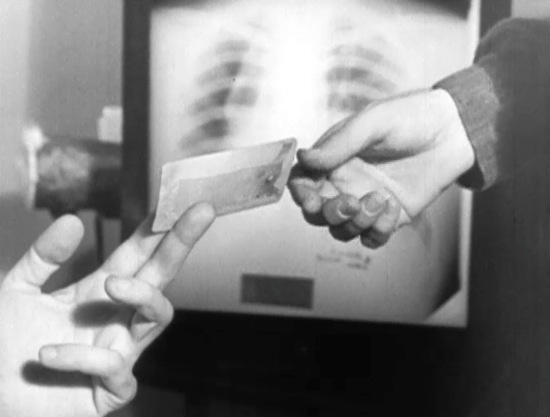
Men and Dust: If the news was not good, it generally foretold death. Image: Library of Congress. (Click on image to view film.)
n
All that was true, and outrage was certainly an appropriate response. At issue is how well Dick conveyed that. He experimented with narrative devices such as a section of speech that clatters like the wheels of a ore train that charges through the past the camera. In many cases, those would likely strike most audience members as more bleating than commanding. It seems unlikely that his stylization would have moved many mine operators in 1940. They, in any case, get off quite lightly in Dick’s film, while he depicts as champions of combatting health dangers officials of the International Union of Mine, Mill and Smelter Workers.
Yet for all its odd mix of realism, drama, melodrama, and advocacy, the film stands as a landmark work in occupational- and environmental-health history, one that in its framing and moods resembles Sheldon Dick’s earlier photography. There, too, he sought to bear witness.
If Dick’s ideological pitch and urgent advocacy seem as much exertion as commitment, that would seem to resonate with his life, which began with wealth, proceeded uncertainly, and ended pitifully.
Born in Chicago in 1906 as the fourth son of a wealthy producer of mimeograph printers, he married at 21, studied at the University of Cambridge, and soon after returning to New York was separated and then divorced in 1932, losing his infant daughter in the process.
During a failed attempt at book printing and publishing, he married again in 1933 to Mary Lee Burgess — Lee Dick, his later film collaborator. He made a halting start in photography, and it was his ability to work for essentially nothing that explains why he received an invitation to join photographers well-known and obscure in a project of Roy Stryker, who ran the Information Division of the Farm Security Administration.
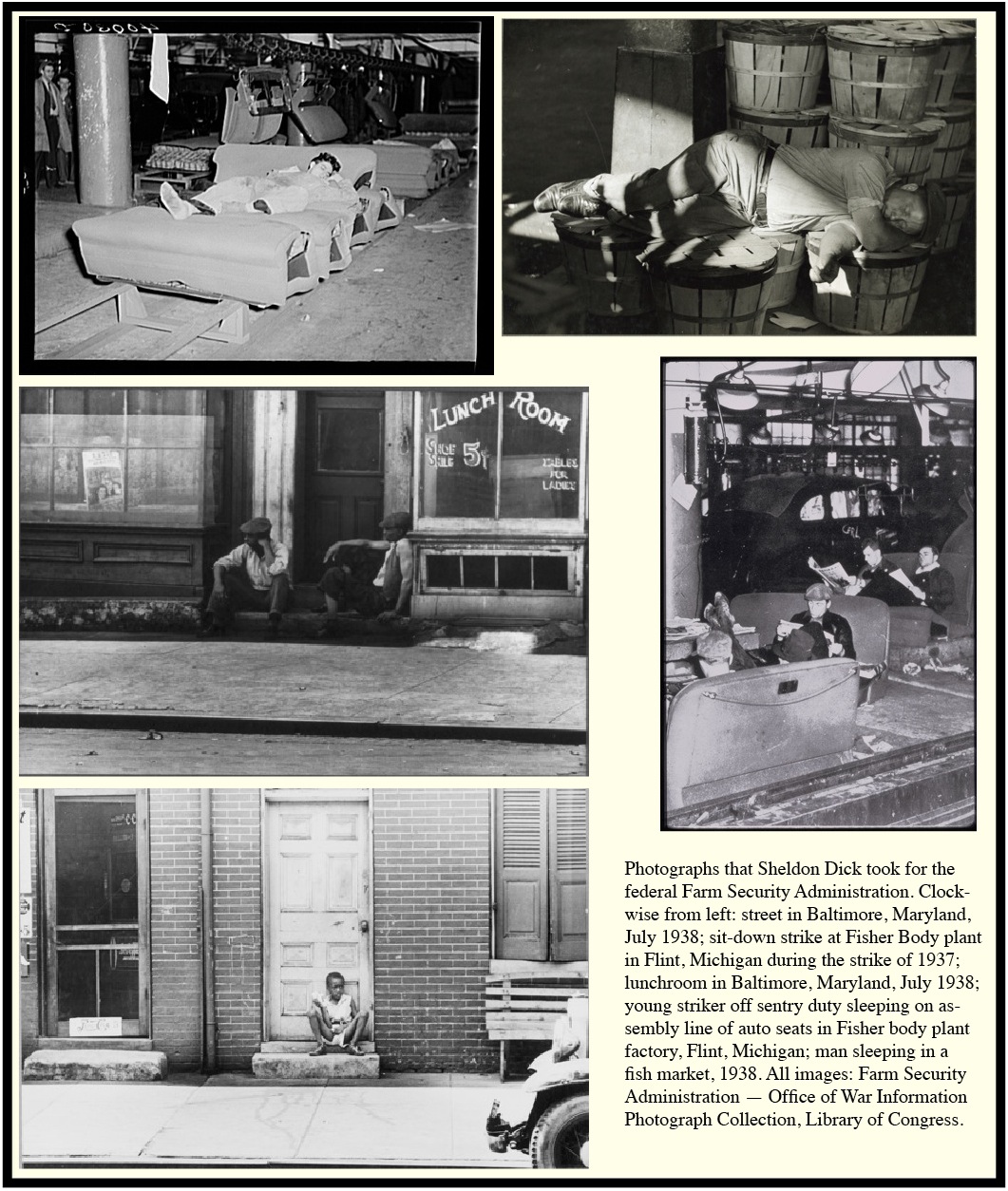
n
Dick didn’t do what Stryker wanted: he took photographs that emphasized faith over the economic reality of the Great Depression; so he lasted with the project only until 1938, the year after he joined it. But he was rich, so traveled as he wished. This was the source of much of his remaining photography, but his championing of miners’ rights resulted from a trip he made to Joplin, Missouri, at Stryker’s request.
In 1940, he contributed significantly to a second film, Day After Day. But this time he worked as a writer and cameraman for director Fred Stewart. It was a sponsored film Dick and Stewart made for the Henry Street Visiting Nursing Service, which became a model public-health nursing program for its work among the poor on Manhattan’s Lower East Side.
Little more remains to be said of Dick’s life other than to relate its sorry end. By 1950 he had been divorced for a second time, and married for a third, this time to Elizabeth Durand Dick. They lived on six acres in Westport, Connecticut. He played polo. The morning of May 12, Dick phoned the police and said, according to a New York Times report the next day: “We have just killed ourselves. Send an officer right away.”
He had preemptively reported his own death, and his wife’s, in an idiosyncratic manner. Police arrived within a few minutes of their deaths, both caused by one shot in the head from a .45—caliber Navy-issue pistol, with no signs of any struggle. The couple’s three children, aged two to nine, and three servants, slept through the shootings. State police recorded the shootings as “murder and suicide” while the medical examiner characterized Dick’s actions as “a case of temporary insanity.”
His former FSA chief, Roy Stryker, said in a mid-1960s interview that he found Dick ”one of the worst cases I’ve ever known in my experience of the wealthy son who couldn’t get away from it.”
He called Dick “a terribly nice boy [who] was a little worried about the fact that he was a checkbook — he was a checkbook for the left-wingers at the time” and one “who got rather worried about not having something that he really could do.”
Dick never lost that sensitivity, Stryker said: “I saw him many times afterward and I saw the resentment that he had toward having been the checkbook for some of the leftwingers and others. He never had a chance to be himself.”
Even today, millions of workers, most in construction and sandblasting settings, are blithely exposed to the dangers of silica dust. In Deadly Dust, Rosner and Markowitz noted that the silica dust rule that OSHA issued in 1971 left workers exposed to far-from-safe concentrations.
The U.S. Occupational Safety and Health Administration has proposed a new standard on silica exposure to tighten those 1971 regulations, but observers such as Michael L. Marlow, a specialist in regulatory policy, are skeptical. Marlow flatly states: “Until [OSHA] finds a way to ensure that businesses follow the current rules for protecting workers, a more stringent limit on silica exposure likely will not help improve worker safety.”
He notes that many workers have been found to be exposed to silica in excess of five times the proposed new permissible exposure limit. In any case, others have observed, OSHA sent the proposal to the White House two years ago, and it languished there due to intense industry lobbying.
Therein lies an old tale. From Sheldon Dicks’s day on, miners have come forward, faces etched with pain, to seek compensation that supposedly is due to them. But over and over, victims have suffered the duplicity of mining companies that doggedly evade admitting the source of their ex-employees’ black lung. Federal law stipulates that compensation payments come from the last mining company for which a claimant worked for more than one year, and coal companies must decide between being bankrupted by claims and contesting virtually all of them so vigorously that delays often exceed victim’s remaining years of life.
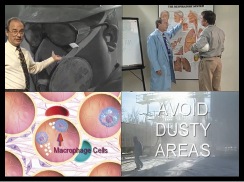
“Silicosis: A Preventable Disease” (1999). Credit: Mine Safety and Health Administration, Creative Commons Attribution license. (Click on image to view film, which first runs in English, and then with Spanish voice-over.)
Pneumoconiosis sufferers have long found themselves in what Andrew Wolfe McThenia Jr, a retired law professor who in 1996 started Washington and Lee University’s student-staffed legal-aid Black Lung Clinic, has described as “Dickens’ worst idea of the law.”
Often, clients die from the untreatable disease before their claims for benefits are resolved. Many surviving widows have become conversant with relevant federal laws and regulations, but have rarely fared better in pressing cases.
As Rosner and Markowitz write in their book, an acknowledged and influential master study of workplace hazards when it first appeared in 1991, the diseases has persisted into this century, although largely below the radar of popular awareness.
— Peter Monaghan
Previous Post: SPEAKING IN PALINDROMES
Next Post: The Great War in Film and Cultural Memory

